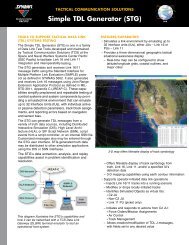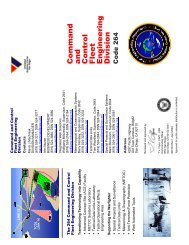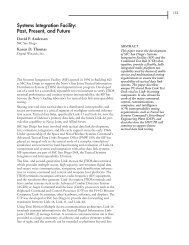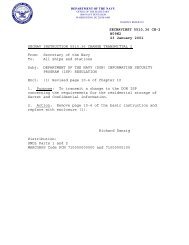Intelligence, Surveillance, and Reconnaissance - Spawar
Intelligence, Surveillance, and Reconnaissance - Spawar
Intelligence, Surveillance, and Reconnaissance - Spawar
Create successful ePaper yourself
Turn your PDF publications into a flip-book with our unique Google optimized e-Paper software.
172<br />
INTELLIGENCE, SURVEILLANCE, AND RECONNAISSANCE<br />
on average than the NEKF IMM <strong>and</strong> 3 meters per<br />
second better on average than the IMM. Figure 4 is<br />
the course error, <strong>and</strong> it shows, once again, the NEKF<br />
IMM having a much smaller error than the other filters.<br />
The NEKF IMM course error is 9 degrees lower<br />
on average than the EKF <strong>and</strong> 6 degrees lower on<br />
average than the IMM. Table 1 shows the peak errors<br />
from all four statistics (position, velocity, speed, <strong>and</strong><br />
course). The NEKF IMM has the smallest peak error<br />
for position, velocity, <strong>and</strong> course. What this implies is<br />
that the velocity vectors for the NEKF IMM were<br />
more accurate than the EKF <strong>and</strong> the IMM filters.<br />
Since the velocity vectors were pointing closer to<br />
truth, the position error for the NEKF IMM was<br />
much smaller than the EKF <strong>and</strong> IMM filters. For the<br />
peak speed error, the NEKF IMM performed the<br />
poorest. The reason for this was that the neural network<br />
inside the NEKF IMM was over-correcting<br />
the velocity estimates at each prediction. This overcorrection<br />
was due to the lag in adaptation. Never-<br />
theless, the NEKF IMM outperformed the EKF <strong>and</strong> IMM in all but one<br />
of the error statistics. Figure 5 is a plot that shows the error reduction in<br />
position as time progresses. The plot is an ensemble average of a Monte<br />
Carlo average. Both the IMM <strong>and</strong> the EKF provide little or no error<br />
reduction in the figure. In fact, they do worse than just following the<br />
noisy measurements. The NEKF IMM continually increases positively<br />
showing that it is consistently performing better than the noisy measurements<br />
alone <strong>and</strong> performing noise reduction throughout the maneuver.<br />
TABLE 1. Peak errors for 100 Monte Carlo runs.<br />
Peak Errors NEKF IMM IMM EKF<br />
Position (m)<br />
15.9<br />
18.4 23.0<br />
Velocity (m/s) 21.5<br />
16.2 15.5<br />
Speed (m/s)<br />
19.3<br />
9.1<br />
2.9<br />
Course (deg) 11.1<br />
17.0 17.6<br />
CONCLUSIONS<br />
This paper described the NEKF embedded in an IMM architecture for<br />
the target-tracking problem. The NEKF uses a neural network to adapt<br />
online to unmodeled dynamics or nonlinearities in the target trajectory.<br />
This online adaptation provides for a robust state estimation for tracking<br />
applications because the maneuvers do not have to be known beforeh<strong>and</strong>.<br />
The NEKF is a generic state estimator that can be used to estimate any<br />
state vector such as position, velocity, magnetic moment, frequency signatures,<br />
etc. Comparisons were performed with an extended Kalman filter,<br />
a three-model IMM filter, <strong>and</strong> an NEKF IMM with three models.<br />
The NEKF IMM outperformed the other filters in every case except for<br />
speed error. Further investigation into why the NEKF IMM did not outperform<br />
the filters in speed is now under investigation.<br />
ENSEMBLE AVERAGE STATISTIC (m)<br />
–500<br />
0<br />
500<br />
1000<br />
1500<br />
2000<br />
2500<br />
3000<br />
MONTECARLO AVERAGE OF AN ENSEMBLE AVERAGE<br />
KF<br />
IMM<br />
NEKF IMM<br />
3500<br />
0 100 200 300<br />
TIME (s)<br />
400 500 600<br />
FIGURE 5. NEKF IMM, IMM, <strong>and</strong> EKF ensemble average for 100<br />
Monte Carlo runs.









